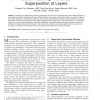Free Online Productivity Tools
i2Speak
i2Symbol
i2OCR
iTex2Img
iWeb2Print
iWeb2Shot
i2Type
iPdf2Split
iPdf2Merge
i2Bopomofo
i2Arabic
i2Style
i2Image
i2PDF
iLatex2Rtf
Sci2ools
PAMI
2006
2006
Stereo Matching with Linear Superposition of Layers
In this paper, we address stereo matching in the presence of a class of non-Lambertian effects, where image formation can be modeled as the additive superposition of layers at different depths. The presence of such effects makes it impossible for traditional stereo vision algorithms to recover depths using direct color matching-based methods. We develop several techniques to estimate both depths and colors of the component layers. Depth hypotheses are enumerated in pairs, one from each layer, in a nested plane sweep. For each pair of depth hypotheses, matching is accomplished using spatial-temporal differencing. We then use graph cut optimization to solve for the depths of both layers. This is followed by an iterative color update algorithm which we proved to be convergent. Our algorithm recovers depth and color estimates for both synthetic and real image sequences.
| Added | 14 Dec 2010 |
| Updated | 14 Dec 2010 |
| Type | Journal |
| Year | 2006 |
| Where | PAMI |
| Authors | Yanghai Tsin, Sing Bing Kang, Richard Szeliski |
Comments (0)

